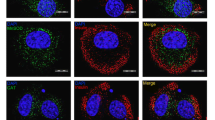Summary
Since copper [Cu(II)] is a necessary cofactor for both intra-mitochondrial enzymes involved in energy production and hydroxyl scavenger enzymes, two hypothesised mechanisms for action of interleukin-Iβ (IL-1β), we studied whether CU(II) addition could prevent the inhibitory effect of IL-1β on insulin release and glucose oxidation in rat pancreatic islets. Islets were incubated with or without 50 U/ml IL-1β, in the presence or absence of various concentrations of Cu(II)-GHL (Cu(II) complexed with glycyl-l-histidyl-l-lysine, a tripeptide known to enhance copper uptake into cultured cells). CuSO4 (1–1000 ng/ml) was used as a control for Cu(II) effect when present as an inorganic salt. At the end of the incubation period, insulin secretion was evaluated in the presence of either 2.8 mmol/l (basal insulin secretion) or 16.7 mmol/l glucose (glucose-induced release). In control islets basal insulin secretion was 92.0±11.4 pg · islet−1 h−1 (mean ± SEM,n=7) and glucose-induced release was 2824.0±249.0 pg · islet−1 h−1. In islets pre-exposed to 50 U/ml IL-1β, basal insulin release was not significantly affected but glucose-induced insulin release was greatly reduced (841.2±76.9,n=7,p<0.005). In islets incubated with IL-1β and Cu-GHL (0.4 μmol/l, maximal effect) basal secretion was 119.0±13.1 pg · islet−1 h−1 and glucose-induced release was 2797.2±242.2, (n=7,p<0.01 in respect to islets exposed to IL-1β alone). In contrast to data obtained with Cu(II)-GHL, increasing concentrations of CuSO4 (up to 10 μmol/l) did not influence the inhibitory effect of IL-1β on glucose-stimulated insulin release. Glucose oxidation (in the presence of 16.7 mmol/l glucose) was 31.5±2.4 pmol · islet−1·90min−1 in control islets and 7.0±0.9 (p<0.01) in IL-1β-exposed islets. In islets exposed to IL-1β and Cu-GHL glucose oxidation was similar to control islets (31.9±1.9). In contrast, Cu-GHL did not prevent the IL-1β-induced increase in nitric oxide production. Nitrite levels were 5±1.7, 26±5 and to 29±4 pmol · islet−1·48 h−1 (mean ± SEM,n=5) in the culture medium from control IL-1β and IL-1β+Cu-GHL exposed islets, respectively. These data indicate that the Cu(II) complexed to GHL is able to prevent the inhibitory effects of IL-1β on insulin secretion and glucose oxidation, but not on NO production. The mechanism of action of Cu-GHL is still unclear, but it might restore the activity of the enzymatic systems inhibited by IL-1β. [Diabetologia (1995) 38∶39–45]
Similar content being viewed by others
Abbreviations
- Cu-GHL:
-
Copper-glycyl-l-histidyl-l-lysine
- IL-1β:
-
interleukin-1β
- NO:
-
nitric oxide
- SOD:
-
superoxide dismutase
- KRBB:
-
Krebs Ringer bicarbonate buffer
- HBBS:
-
Hanks balanced salt solution
References
Dinarello CA (1984) Interleukin 1 and the pathogenesis of the acute-phase response. N Engl J Med 311:1413–1418
Mandrup-Poulsen T, Zumsteg U, Reimers J et al. (1993) Involvement of interleukin-1 and interleukin-1 receptor antagonist in pancreatic beta-cell destruction in insulin-dependent diabetes mellitus. Cytokine 5: 185–191
McDaniel ML, Hughes JH, Wolf BA, Easom RA, Turk JW (1988) Descriptive and mechanistic considerations of interleukin 1 and insulin secretion. Diabetes 37:1311–1315
Zawalich WS, Diaz VA (1986) Interleukin-1 inhibits insulin secretion from isolated perifused rat islets. Diabetes 35:1119–1123
Sandler S, Andersson A, Hellerström C (1987) Inhibitory effects of interleukin 1 on insulin secretion, insulin biosynthesis and oxidative metabolism of isolated rat pancreatic islets. Endocrinology 121:1424–1431
Comens PG, Wolf PA, Unanue ER, Lacy PE, McDaniel ML (1987) Interleukin 1 is potent modulator of insulin secretion from isolated rat islet of Langerhans. Diabetes 36:963–970
Rabinovitch A, Pukel C, Baquerizo H (1988) Interleukin-1 inhibits glucose- modulated insulin and glucagon secretion in rat islet monolayer cultures. Endocrinology 122:2393–2397
Eizirik DL Strandell E, Bendtzen K, Sandler S (1988) Functional characteristics of rat pancreatic islets maintained in culture following exposure to human interleukin 1. Diabetes 37:916–919
Purrello F, Buscema M (1993) Effects of interleukin 1β on insulin secretion by pancreatic beta-cells. Diab Nutr Metab 6:295–304
Ling Z, In'tVeld P, Pipeleers DG (1993) Interaction of interleukin-1 with islet β-cells. Distinction between indirect, aspecific cytotoxity and direct, specific functional suppression. Diabetes 42:56–65
Southern C, Schulster D, Green IC (1990) Inhibition of insulin secretion by interleukin-1β and tumour necrosis factor-a via an L-arginine dependent nitric oxide generating mechanism. FEBS Lett 276:42–44
Kroncke KD, Kolb-Bachofen V, Berschick B, Burkart V, Kolb H (1991) Activated macrophages kill pancreatic syngenic islet cells via arginine-dependent nitric oxide generation. Biochem Biophys Res Commun 175:752–758
Welsh N, Eizirik DL, Bendtzen K, Sandler S (1991) Interleukin-1β induced nitric oxide production in isolated rat pancreatic islets requires gene transcription and may lead to inhibition of the Krebs cycle enzyme aconitase. Endocrinology 129:3167–3173
McDaniel ML, Corbett JA (1992) Does nitric oxide mediate autoimmune destruction of β-cells? Possible therapeutic interventions in IDDM. Diabetes 41:897–903
Corbett JA, Wang JL, Hughes JH, Wolf BA, Sweetland MA, Lancaster JR, McDaniel ML (1992) Nitric oxide and cyclic GMP formation induced by interleukin 1β in islets of Langerhans. Biochem J 287:229–235
Corbett JA, McDaniel ML (1994) Reversibility of interleukin-1β-induced islet destruction and dysfunction by the inhibition of nitric oxide synthase. Biochem J 299:719–724
Eizirik DL, Sandler S, Welsh N et al. (1994) Cytokines suppress human islet function irrespective of their effects on nitric oxide generation. J Clin Invest 93:1968–1974
Sorenson JRJ (1982) Metal ions in biological systems. In: Sigel H (ed) RRR. Dekker, New York
Klevay LM (1982) Inflammatory diseases and copper. In: Sorensen JRJ (ed) RRR. Humana, Clifton, New Jersey
Rainer MJA, Rode BM (1984) The complex formation of copper(II) with GHL and HSA. Inorganica Chimica Acta 92:1–7
Purrello F, Vetri M, Gatta C, Gullo D Vigneri R (1989) Effects of high glucose on insulin secretion by isolated rat islets and purified B-cells and possible role of glycosylation. Diabetes 38:1417–1422
Buscema M, Rabuazzo A M, Vinci C, Caltabiano V, Vigneri R, Purrello F (1993) Different effects of glucose and glyburide on insulin secretion in rat pancreatic islets preexposed to interleukin-1β. Possible involvement of K+ and Ca2+ channels. Diabetologia 36:791–796
Svensson C, Hellerström C (1991) Long-term effects of a high glucose concentration in vitro on the oxidative metabolism and insulin production of isolated rat pancreatic islets. Metabolism 40:513–518
Goldstein S, Michel C, Bors W, Saran M, Czapski G (1988) A critical reevaluation of some assay methods for superoxide dismutase activity. Free Radic Biol Med 4:295–303
Mc Cord JM, Fridovich I (1969) Superoxide dismutase (an enzymic function erythrocuprein). J Biol Chem 244:6049–6055
Lau S, Sarkar B (1981) The interaction of copper(II) and glycyl-L-histidyl-L-lysine, a growth-modulating tripeptide from plasma. Biochem J 199:649–656
Rainer MJA, Rode BM (1984) The complex formation of copper (II) with GHL and HSA. Inorganica Chimica Acta 92:1–7
Corbett JA, Wang JL, Sweetland MA, Lancaster JR, McDaniel ML (1992) Interleukin 1β induces the formation of nitric oxide by β-cells purified from rodent islets of Langerhans. J Clin Invest 90:2384–2391
Ruggiero CL, Carrier SM, Antholine WE, Whittaker JM, Cramer CJ, Tolman WB (1993) Synthesis and structural and spectroscopic characterization of mononuclear copper nitrosyl complexes: models for nitric oxide adducts of copper proteins and copper-exchanged zeolites. J AM Chem Soc 115:11285–11298
Eizirik DL, Welsh N, Niemann A, Velloso LA, Malaisse WJ (1994) Succinic acid monomethyl ester protects rat pancreatic islets secretory potential against interleukin-1 beta (IL-1 beta) without affecting glutamate decarboxylase expression or nitric oxide production. FEBS Lett 337:298–302
Welsh N, Sandler S (1992) Interleukin-1β induces nitric oxide production and inhibits the activity of aconitase without decreasing glucose oxidation rates in isolated mouse pancreatic islets. Biochem Biophys Res Comm 182:333–340
Steinkuhler C, Sapora O, Carri MT et al. (1991) Increase of Cu,Zn-superoxide dismutase activity during differentiation of human K562 cells involves activation by copper of a constantly expressed copper-deficient protein. J Biol Chem 266:24580–24587
Borg LA, Cagliero E, Sandler S, Welsh N, Eizirik DL (1992) Interleukin-1 beta increases the activity of superoxide dismutase in rat pancreatic islets. Endocrinology 130:2851–2857
Giannello E, Murphy D, Maguacca G et al. (1992) The interaction of NO with copper ions in ZSM5: an EPR and IR investigation. J Catalysis 136:510–520
Author information
Authors and Affiliations
Rights and permissions
About this article
Cite this article
Vinci, C., Caltabiano, V., Santoro, A.M. et al. Copper addition prevents the inhibitory effects of interleukin 1-β on rat pancreatic islets. Diabetologia 38, 39–45 (1995). https://doi.org/10.1007/BF02369351
Received:
Revised:
Issue Date:
DOI: https://doi.org/10.1007/BF02369351




